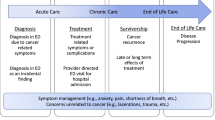Abstract
Background
Oncology patients disproportionately utilize the emergency department (ED) for symptom management. At our institution, approximately 1 in 4 visits to the ED by oncology patients led to discharge. We hypothesized that many of the visits leading to ED discharge would be potentially preventable (PP).
Methods
We retrospectively characterized ED discharges of oncology patients. Visits were classified by presenting symptom, type of cancer, and time of ED visit. Chart reviewers were additionally asked whether each case could have been safely managed as an outpatient.
Results
We analyzed 100 ED discharges in a 4-month period in 2016 and 2017. Gastrointestinal (GI) complaints, pain, and fever were the most common presenting symptoms for these visits. We rated 44 of 100 ED discharges as potentially preventable. Given we analyzed only ED discharges which comprise about 25% of ED visits for patients with cancer, overall about 10% of all ED visits by these patients may be preventable. We also found that ED visits without a clinic appointment or phone call to the clinic on the day of ED presentation were more likely to be preventable (51% vs 27%, OR 2.9, p = 0.026).
Conclusions
Many ED visits by oncology patients may be preventable and occur for symptoms which can be managed as an outpatient. More of these visits also appear to occur in those who do not reach a clinic member prior to the visit. These findings suggest that improved access to clinics and standardized outpatient symptom management are next steps to consider in preventing ED visits in this vulnerable population.


Similar content being viewed by others
References
Hsu J, Donnelly JP, Moore JX, Meneses K, Williams G, Wang HE (2018) National characteristics of emergency department visits by patients with cancer in the United States. Am J Emerg Med. 36:2038–2043. https://doi.org/10.1016/j.ajem.2018.03.025
Centers for Medicare & Medicaid Services (2020) Admissions and emergency department (ED) visits chemotherapy, patients receiving outpatient chemotherapy. https://www.cms.gov/Medicare/Quality-Initiatives-Patient-Assessment-Instruments/HospitalQualityInits/Measure-Methodology. Accessed 03/01/2020
Basch E, Deal AM, Kris MG, Scher HI, Hudis CA, Sabbatini P, Rogak L, Bennett AV, Dueck AC, Atkinson TM, Chou JF, Dulko D, Sit L, Barz A, Novotny P, Fruscione M, Sloan JA, Schrag D (2016) Symptom monitoring with patient-reported outcomes during routine cancer treatment: a randomized controlled trial. J Clin Oncol. 34:557–565. https://doi.org/10.1200/JCO.2015.63.0830
Daly B, Nicholas K, Gorenshteyn D et al (2018) Misery loves company: presenting symptom clusters to urgent care by patients receiving antineoplastic therapy. J Oncol Pract. https://doi.org/10.1200/JOP.18.00199
Delgado-Guay MO, Kim YJ, Shin SH, Chisholm G, Williams J, Allo J, Bruera E (2015) Avoidable and unavoidable visits to the emergency department among patients with advanced cancer receiving outpatient palliative care. J Pain Symptom Manage. 49:497–504. https://doi.org/10.1016/j.jpainsymman.2014.07.007
Brooks GA, Abrams TA, Meyerhardt JA, Enzinger PC, Sommer K, Dalby CK, Uno H, Jacobson JO, Fuchs CS, Schrag D (2014) Identification of potentially avoidable hospitalizations in patients with GI cancer. J Clin Oncol. 32:496–503. https://doi.org/10.1200/JCO.2013.52.4330
Panattoni L, Fedorenko C, Greenwood-Hickman MA, Kreizenbeck K, Walker JR, Martins R, Eaton KD, Rieke JW, Conklin T, Smith B, Lyman G, Ramsey SD (2018) Characterizing potentially preventable cancer- and chronic disease–related emergency department use in the year after treatment initiation: a regional study. J Oncol Pract. 14:e176–e185. https://doi.org/10.1200/jop.2017.028191
Caterino JM, Adler D, Durham DD, Yeung SCJ, Hudson MF, Bastani A, Bernstein SL, Baugh CW, Coyne CJ, Grudzen CR, Henning DJ, Klotz A, Madsen TE, Pallin DJ, Reyes-Gibby CC, Rico JF, Ryan RJ, Shapiro NI, Swor R, Venkat A, Wilson J, Thomas CR Jr, Bischof JJ, Lyman GH (2019) Analysis of diagnoses, symptoms, medications, and admissions among patients with cancer presenting to emergency departments. JAMA Netw Open. 2:e190979. https://doi.org/10.1001/jamanetworkopen.2019.0979
Handley NR, Schuchter LM, Bekelman JE (2018) Best practices for reducing unplanned acute care for patients with cancer. J Oncol Pract. 14:306–313. https://doi.org/10.1200/jop.17.00081
Kirkland SW, Garrido-Clua M, Junqueira DR, Campbell S, Rowe BH (2020) Preventing emergency department visits among patients with cancer: a scoping review. Support Care Cancer. 28:4077–4094. https://doi.org/10.1007/s00520-020-05490-1
Funding
This study was financially supported by the Center for Healthcare Delivery Science, Beth Israel Deaconess Medical Center, Boston, MA.
Author information
Authors and Affiliations
Contributions
M .R and J.A.Z: study development. M.R, B.H, and D.C: conducting chart review. S.D: project manager for implementation studies. R.G: data collection.
Corresponding author
Ethics declarations
Conflict of interest
The authors declare that they have no conflicts of interest.
Additional information
Publisher’s note
Springer Nature remains neutral with regard to jurisdictional claims in published maps and institutional affiliations.
Key message
Up to 40% of patients with cancer who are discharged from the emergency department may have potentially preventable visits, representing approximately 10% of all cancer patients presenting to the emergency department. Most of the visits fall under common symptom categories that may have potential for outpatient management.
Rights and permissions
About this article
Cite this article
Roy, M., Halbert, B., Devlin, S. et al. From metrics to practice: identifying preventable emergency department visits for patients with cancer. Support Care Cancer 29, 3571–3575 (2021). https://doi.org/10.1007/s00520-020-05874-3
Received:
Accepted:
Published:
Issue Date:
DOI: https://doi.org/10.1007/s00520-020-05874-3




